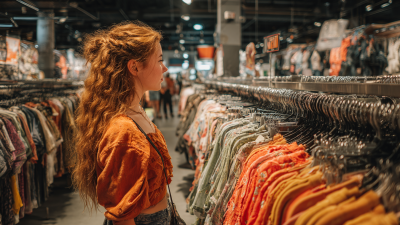How to Choose Sustainable Clothing: Insights from the Apparel Industry's Eco-Trends
In today's world, where the impact of fashion on the environment is becoming increasingly scrutinized, choosing sustainable clothing has never been more crucial. The apparel industry is undergoing a transformative shift, driven by eco-conscious consumers who are seeking to reduce their carbon footprint and support ethical practices. This blog aims to explore the principles of selecting sustainable clothing, offering insights into current eco-trends that are shaping the future of fashion. From understanding the importance of materials to recognizing the significance of supply chain transparency, we will guide you through the essential factors to consider when making responsible clothing choices. By adopting a more thoughtful approach to your wardrobe, you not only contribute to environmental preservation but also support brands committed to sustainable practices, paving the way for a greener future in fashion.

Understanding Sustainable Fabrics: What to Look For
When selecting sustainable clothing, understanding the fabrics used is crucial to ensuring eco-friendliness. Sustainable fabrics are typically made from materials that have a reduced environmental impact throughout their lifecycle. Look for organic cotton, which is grown without harmful pesticides or fertilizers, and is not only better for the planet but also for the health of farmers.
Another excellent choice is Tencel, a fiber made from sustainably sourced wood, which uses a closed-loop process to recycle water and solvents, minimizing waste.
Additionally, keep an eye out for recycled materials, such as recycled polyester, which is often derived from post-consumer plastics. This not only helps divert waste from landfills but also reduces the demand for new raw materials.
Fabrics like hemp and linen are also great options, as they require fewer resources to produce and have a lower carbon footprint. By prioritizing these materials in your clothing choices, you can significantly contribute to a more sustainable fashion industry while enjoying stylish and functional apparel.
The Role of Certifications in Eco-Friendly Clothing
When it comes to choosing sustainable clothing, understanding the role of certifications can significantly impact your purchasing decisions. Certifications serve as a vital tool for consumers seeking eco-friendly options in the apparel industry, ensuring products meet rigorous environmental and ethical standards. For instance, according to the Global Organic Textile Standard (GOTS), textiles certified by GOTS are made from organic fibers and produced without harmful chemicals, making them a safe choice for both the environment and your skin.

To help you make informed decisions, look for certifications like OEKO-TEX® Standard 100, which tests for harmful substances, or the Fair Trade Certified label, which guarantees ethical labor practices. Brands that seek these certifications often adhere to strict eco-trends, as the Sustainable Apparel Coalition's Higg Index suggests that companies prioritizing sustainability reporting are more likely to elevate their environmental performance.
Tips for choosing sustainable clothing include researching brands’ certification statuses and prioritizing those that have transparent supply chains. Additionally, consider the longevity and recyclability of garments—options that not only reduce waste but contribute to a circular economy. By selecting certified apparel, you empower the movement towards more responsible consumption in the fashion industry while ensuring your choices align with eco-conscious values.
Identifying Ethical Brands: Beyond Marketing Claims
When it comes to choosing sustainable clothing, navigating the sea of marketing claims can be challenging. Many brands tout their eco-friendly initiatives and ethical practices, but it’s essential to delve deeper than these surface-level assertions. Start by researching a brand's supply chain transparency. Look for companies that disclose information about their material sources, labor practices, and environmental impact. Brands committed to sustainability often provide detailed reports on their efforts and partnerships with third-party organizations that validate their claims.
Another key aspect in identifying truly ethical brands is their commitment to fair labor practices. Investigate whether the company has a clear stance on worker rights and if they adhere to fair wages and safe working conditions. Certifications from reputable organizations can offer additional assurance. Moreover, engage with the brand’s community—read reviews, seek testimonials from other consumers, and monitor their social media interactions. Genuine brands will engage authentically with their customers, showcasing their commitment to not just selling clothing, but fostering a culture of sustainability and ethical responsibility.
Consumer Preferences for Sustainable Clothing
The Impact of Fast Fashion on Sustainability: What Consumers Should Know
The fast fashion industry has significantly impacted sustainability, pushing consumers to become more cognizant of their shopping habits. With the relentless cycle of trends and the rapid production of low-cost garments, the environmental toll is substantial. Overconsumption results in textile waste, pollution, and exploitation of labor. Therefore, understanding the implications of fast fashion is essential for making informed decisions.
**Tips:** To contribute to sustainability, consider investing in high-quality pieces that will last longer rather than disposable items that quickly go out of style. Focus on brands that prioritize ethical manufacturing practices and use sustainable materials. Additionally, exploring second-hand options is a fantastic way to reduce waste while finding unique clothing items.
As consumers, we hold considerable power. By supporting sustainable brands and being mindful of our purchases, we can collectively mitigate the adverse effects of fast fashion. Every choice counts, whether it’s opting for timeless designs or participating in clothing swaps with friends to extend the lifecycle of our wardrobes.

Practical Tips for Building a Sustainable Wardrobe
Building a sustainable wardrobe is a rewarding journey that not only benefits the environment but also promotes mindful consumerism. To start, focus on choosing pieces made from eco-friendly materials, such as organic cotton, Tencel, or recycled fabrics. These materials often have a lower impact on the environment compared to conventional textiles.
Additionally, consider the longevity of the items you plan to acquire; investing in high-quality pieces that are designed to last will reduce the frequency of replacements and ultimately minimize waste.
Another practical tip is to embrace the concept of a capsule wardrobe. This approach encourages you to curate a collection of versatile clothing that can be mixed and matched, allowing you to create various outfits without the need for excessive spending. Thrift shopping and swapping clothes with friends are also excellent ways to find unique pieces while promoting a circular fashion economy. Lastly, always pay attention to the brands you support; look for companies committed to sustainable practices, such as transparency in their supply chain and fair labor standards. These steps can help you build a wardrobe that aligns with your values and supports a healthier planet.
Related Posts
-

How to Select the Best Clothing Shop for Your Global Sourcing Needs
-

Challenges Faced by Clothing Stores in Adapting to Consumer Trends
-

How to Choose the Perfect Sports Wear for Your Active Lifestyle
-

Unlocking Comfort: The Health Benefits of Choosing Quality Men's Boxer Shorts
-

7 Effective Tips to Choose the Best Gym Wear for Your Fitness Journey
-

Ultimate Guide to Finding the Best Deals on Discount Clothing Online

